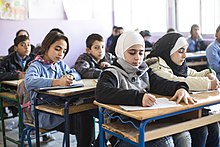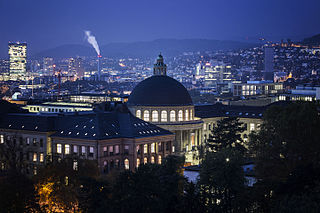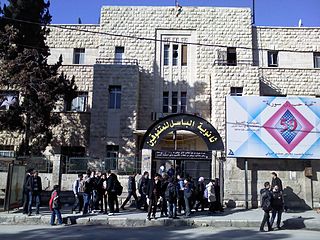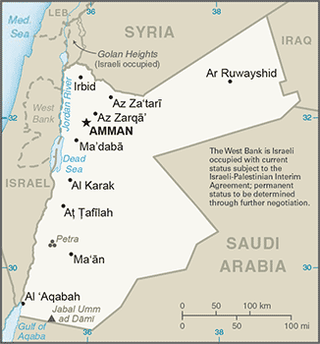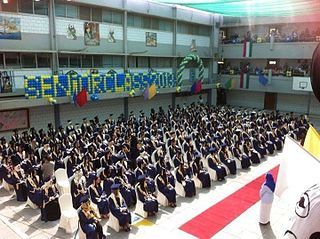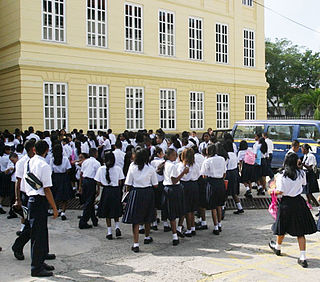Education System
The Lebanese educational system consists of 5 cycles, which are divided among 3 main subdivisions: the preschool, basic, and secondary stages. The stage of preschool education (cycle 1) begins at the age of 3 or 4. Basic education, which is considered compulsory, continues from the age of 6 to the age of 14. [2] It includes two levels: the elementary and intermediate level. The elementary phase includes grades 1 to 3 (cycle 2), and grades 4 to 6 (cycle 3). The intermediate level comprises grades 7 to 9 (cycle 4). Finally, the stage of secondary education continues from grades 10 to 12 (cycle 5). It is usually completed at the age of 18, [9] and ends with a Baccalaureat or professional certificate, of which either can give access to tertiary education. [9]
It is worth noting that an estimated two-thirds of Lebanese students attend private schools. [10] In April 2015, the Minister of Education, Elias Bou Saab, acknowledged the myriad challenges and gaps that exist in the Lebanese school system, and the public schools, particularly. While the Lebanese law stipulates that the national curriculum should be updated every four years, it has not been updated since 2000. Plus, because of the national disagreement over Lebanon's modern history, history textbooks cover historical events before 1945 only.
The national exams (Grade 9 Brevet and Grade 12 Baccalaureate) were not graded in 2014. [11]
Preschool Education
Preschool education aims to initiate children into the school environment. The goal of pre-school education is to create a favorable climate for children to communicate with others, develop their physical capacities, limb control and coordination of their movements, and educate their senses. Preschool education also takes into account the physiological, moral, and intellectual development of children. [12] According to the World Bank database, the gross enrollment rate of preschool education is 62.5 percent for male, 68.3 percent for female, and 64.4 percent for total in 2006. [13] Also, the private enrollment share for preschool education marked 80.3 percent in 2008. [13]
Basic education
Elementary Level
According to the Worlds database, gross enrollment rate of elementary level of basic education is for 96.8 percent for male, 93.9 percent for female, and 95.4 percent for total in 2007. Private enrollment share in elementary level is 67.6 percent in 2007. [13]
Intermediate level
Primary completion rate of Lebanon (US$6,000 GNI per capita in 2007) is lower than that of Tunisia, Jordan, Iran, Algeria, West Bank and Egypt (all of which have lower GNI per capita). Primary completion rates have not improved during the period 1995/96 to 2003/04. [14] In 2007, Primary completion rate is 79.8 percent for male, 83.3 percent for female, and 81.5 percent for total. [13] According to UIS database, technical and vocational enrollment as percent of total enrollment in intermediate level is 5.1 percent in 2008. [12] Private enrollment share of general education in intermediate level is 60.2 percent and that of technical and vocational education is 56.8 percent in 2008. [12]
Secondary education
Secondary education is three years education, the first year is common for all students, and the second year is either scientific or literature whereas the third year composes of (humanities, economics, life sciences, general sciences) and technical education (about 55 different fields of study). Most schools, however have deviated from this system. They usually do not offer Humanities education, citing socio-economics as a better and more efficient alternative School principals decide students’ path based on students’ aptitude as shown by the first secondary and second secondary years. When students complete three years education, they take official Lebanese Baccalaureate exams in their respective tracks (four in all). Students who finish examinations successfully obtain the Lebanese Baccalaureate Certificate of Secondary Education (Shahaadat Al-Bakaalouriya al Lubnaaniya l’il-ta ‘liim al-Thaanawi) or the Technical Baccalaureate (Al-Bakaalouriya al-Finniya) [15] In 2014, the Minister of Education passed all students who took the exam, regardless of their score. [16]
According to the United Nations Human Development Index, the gross enrollment rate for secondary school is 74%. [8]
Palestinian refugees in Lebanon have limited access to public secondary education. Most of them are not able to afford the high cost of private secondary education.[ citation needed ] UNRWA operates three secondary schools in Beirut, Saida and Tyre. School operated by UNRWA partially offset the absence of available educational opportunities at the secondary school level. (UNRWA website) According to the World Bank database, gross enrollment rate of secondary education is 69.8 percent for male, 80.2 percent for female, and 74.9 percent for total. [13] According to UIS database, technical and vocational enrollment as percent of total enrollment in secondary level is 27.8 percent in 2008. [12] Private enrollment share of general education in intermediate level is 49.8 percent and that of technical and vocational education is 56.9 percent in 2008. [12]
Lebanon participated in TIMSS in 2003 and 2007. Score of mathematics at 8th grade is 433 in 2003 and 449 in 2007. [17] Score of science at 8th grade is 435 in 2003 and 404 in 2007. [18] At the end of middle school, each student has to enter the official exams.
Tertiary Education
Tertiary education in Lebanon is composed of Technical and Vocational Institutes, University colleges, University Institutes and Universities. The Lebanese University is the only public institution. The Ministry of Education and Higher Education administrates the private and public sectors and Technical and Vocational Institutes are under the Directorate General of Technical and Vocational Education Directorate General of Higher Education has responsibility for University Colleges, University Institutes and Universities). [15]
According to the World Bank database, gross enrollment rate of tertiary education (the percentage of students who go on to tertiary education within five years of completing secondary education) was 48% in 2013. [19]
With university graduates making up 30% of people seeking a job, [20] it is clear that the Higher Education system needs to play a key role in resolving the problem of youth unemployment in Lebanon. The key issue related to this sector is the mismatch between the highly skilled graduates that universities supply and the skills and professionals the labor market demands; these supply-demand failings in the labor market are increasingly preventing young people from finding a job in their country that fits their qualifications. [21] In order to address these issues, universities can implement policies to reform the curricula to better prepare graduates for their professional life, improve career guidance structures and activities, and invest in relevant research, statistics and data gathering.
Lebanon has 41 nationally accredited universities, several of which are internationally recognized. [22] [23] The American University of Beirut (AUB) and the Saint Joseph University of Beirut (USJ) were the first Anglophone and the first Francophone universities to open in Lebanon respectively. [24] [25] The majority of the forty-one universities, both public and private, largely operate in French or English, the two most widely used foreign languages in Lebanon. [26]
At the English speaking universities, students who have graduated from an American-style high school program enter at the freshman level to earn their baccalaureate equivalence from the Ministry of Education and Higher Education. This qualifies them to continue studying at the higher levels. These students are required to have already taken the SAT I and the SAT II (Subjects Test) upon applying to college, in lieu of the official exams. On the other hand, students who have graduated from a school that follows the Lebanese educational system are directly admitted to the sophomore year. These students are still required to take the SAT I, but not the SAT II.
The highest-ranked universities in Lebanon include the American University of Beirut (AUB), the Lebanese American University (LAU), the Saint Joseph University of Beirut (USJ), the Lebanese University (LU), the University of Balamand (UOB), the Université Saint-Esprit de Kaslik (USEK), Beirut Arab University (BAU), the American University of Science and Technology (AUST), the Lebanese International University (LIU), and the Notre Dame University - Louaize (NDU). [27] [28] QS Top Universities ranks AUB second in the Arab world. [28] [29] [30] [31]
Not all private higher educational institutions in Lebanon consider SAT I or SAT II for undergraduate admissions. The majority require a local entrance test prepared by these individual higher educational institutions. In most times, the entrance test is a placement test.[ citation needed ] The main requirement for undergraduate admissions for Lebanese students is the secondary-school leaving certificate called the Baccalaureate II or more recently the International Baccalaureate. However, students with a foreign nationality are admitted to private higher education institutions that pattern after the American system of higher education as Freshman students in case they do not have an equivalence to the Baccalaureate II.[ citation needed ] In case they obtain an equivalence from the Ministry of Education and Higher Education, they are admitted as sophomore students. As for the Lebanese University, which is the only public higher educational institution in Lebanon, students are admitted to undergraduate programs based on the Baccalaureate II certificate. A number of faculties at the Lebanese University, such as the Faculty of Sciences, require further testing for selectivity based on entrance tests (concours) prepared and administered by this faculty.[ citation needed ]
- AUB established in 1866 by the American Board of Commissioners for Foreign Missions.
- Entrance to the Medical Sciences Campus of Saint Joseph University of Beirut. The university was founded in 1875 by French Jesuit missionaries.
- Holy Spirit University of Kaslik, or Université Saint-Esprit de Kaslik, founded by the Lebanese Maronite Order (LMO) in 1938.
- NDU, founded by the Maronite Order of The Holy Virgin Mary in 1978.
- American University of Science and Technology, founded in Achrafieh in 1989.





